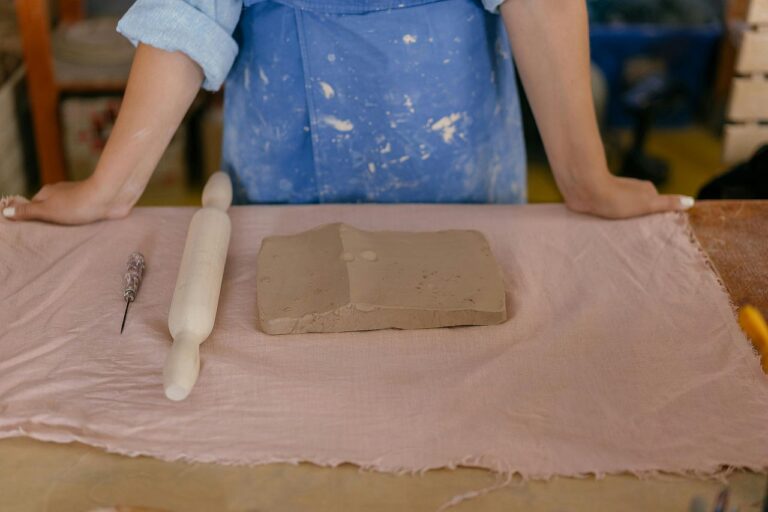How to Choose the Right Clay for Hand-Building
Introduction
Choosing the right clay for hand-building is the foundation of any successful pottery project. With so many options available, it can be overwhelming to know where to start, especially if you’re new to pottery. Should you go for earthenware, stoneware, or porcelain? What about air dry clay? Each type has unique properties that affect how it feels, how it holds its shape, and how it behaves during drying and firing. In this guide, we’ll break down the different types of clay, their benefits, and how to choose the best one for your hand-building projects.
Why the Right Clay Matters
The clay you choose directly impacts your pottery’s durability, finish, and ease of shaping. For instance:
- Soft, pliable clay is perfect for beginners and detailed designs.
- Heavier clay bodies are better for large, sturdy pieces.
- The clay’s firing temperature determines its compatibility with your kiln and glazes.
Selecting the right clay ensures your creations look great, dry properly, and avoid common pitfalls like cracking or warping.
Types of Clay for Hand-Building
Here are the most common types of clay used in hand-building pottery:
1. Earthenware Clay
- Best For: Beginners, decorative pieces, and low-fire pottery.
- Key Features:
- Fires at low temperatures (around 1,830–2,100°F or 1,000–1,150°C).
- Soft and easy to shape.
- Comes in a variety of colors, from white to red.
- Pros:
- Affordable and widely available.
- Holds its shape well during hand-building.
- Compatible with bright, colorful glazes.
- Cons:
- Porous even after firing, so it’s not ideal for functional, watertight pieces.
2. Stoneware Clay
- Best For: Functional pieces like mugs, bowls, and plates.
- Key Features:
- Fires at mid to high temperatures (around 2,100–2,400°F or 1,150–1,300°C).
- More durable and less porous than earthenware.
- Comes in a range of textures, from smooth to gritty.
- Pros:
- Strong and long lasting.
- Less prone to cracking during drying and firing.
- Works well for both beginners and advanced potters.
- Cons:
- Requires a higher firing temperature, which may not be compatible with all kilns.
3. Porcelain Clay
- Best For: Advanced potters and detailed, delicate work.
- Key Features:
- Fires at high temperatures (2,300–2,600°F or 1,260–1,430°C).
- Smooth, fine texture with a white or translucent finish.
- Pros:
- Beautiful, refined appearance.
- Great for intricate designs.
- Cons:
- Difficult to work with due to its softness and lack of plasticity.
- Expensive and requires careful handling during drying and firing.
4. Air-Dry Clay
- Best For: Beginners, kids, and non functional decorative pieces.
- Key Features:
- Does not require firing in a kiln.
- Dries naturally in the air over 24–72 hours.
- Pros:
- Affordable and easy to use.
- Ideal for small projects without access to a kiln.
- Cons:
- Less durable than kiln fired clay.
- Can’t hold water or be used for functional pieces.
Factors to Consider When Choosing Clay
Here’s what to think about when selecting the right clay for your hand-building projects:
1. Skill Level
- Beginners: Start with earthenware or air-dry clay for their forgiving nature and ease of use.
- Intermediate/Advanced: Experiment with stoneware or porcelain to create more durable and intricate pieces.
2. Type of Project
- Functional Items: Stoneware or porcelain is best for mugs, bowls, and plates because of their strength and low porosity.
- Decorative Pieces: Earthenware or air dry clay works well for sculptures, ornaments, or wall art.
3. Firing Temperature
- Check the firing range of your kiln. Low fire kilns are best suited for earthenware, while mid to high fire kilns can handle stoneware and porcelain.
4. Texture
- Smooth Clay: Ideal for fine details, carving, and intricate work.
- Gritty Clay (Grogged Clay): Contains sand or small particles, making it stronger and better for larger projects like vases or sculptures.
5. Budget
- Air dry clay is the most budget friendly option for beginners.
- Porcelain, while beautiful, is the most expensive and requires more skill to handle properly.
Tips for Testing and Choosing Clay
- Buy in Small Quantities First: Try out a few different types of clay to see which one feels best for your style.
- Practice with Soft Clay: If you’re a beginner, softer clays are easier to manipulate and less likely to crack.
- Experiment with Textures: Test both smooth and grogged clay to see which works better for your projects.
Common Mistakes to Avoid
- Choosing the Wrong Texture: Using overly gritty clay for fine details can make shaping and carving difficult.
- Not Considering Firing Needs: Ensure your clay’s firing temperature matches your kiln’s capabilities.
- Skipping Testing: Always test new clay types on small projects before committing to larger ones.
Conclusion
Choosing the right clay for hand-building is a crucial step in your pottery journey. By understanding the properties of different clay types, like earthenware, stoneware, porcelain, and air dry clay, you can select the best material for your project, skill level, and firing setup. Whether you’re creating functional pottery or decorative pieces, experimenting with different clays will help you discover what works best for your style and vision. Happy potting!








